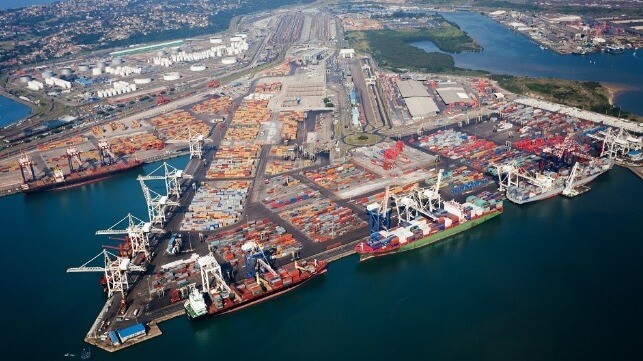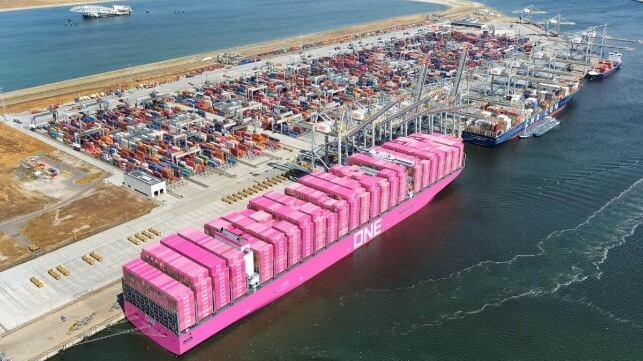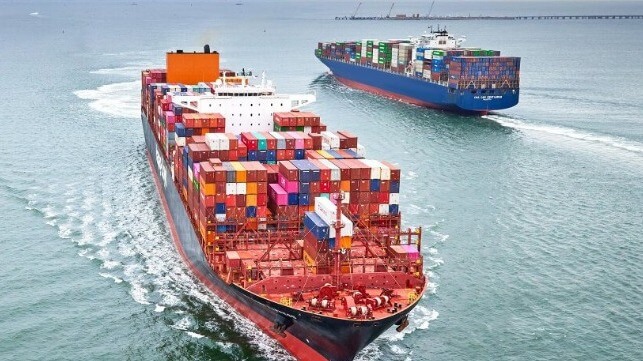South Africa Buys Tugboats as Efforts Proceed to Improve Port Efficiency

South Africa’s ports operator Transnet reports it is moving forward with a fleet renewal program as part of an overall effort to tackle the perennial challenges of inefficiencies that have placed the ports at the bottom of international rankings and led to massive delays and congestion. Transnet National Ports Authority said it will invest $52 million to acquire seven tugboats to be used at Durban and East London.
Two contracts were awarded to Damen Shipyards Cape Town to deliver the seven tugboats between April and August. The new tugboats will replace aging crafts that have reached their operational lifespan. The company said the new tugboats boast will have the latest hull design and propulsion, as well as a 60-ton bollard pull which is a much-needed improvement from the bollard pull of the existing tugboats that range between 32 and 40-ton bollard pull. The new crafts will also be highly maneuverable while guiding larger vessels.
“This investment demonstrates TNPA’s ongoing commitment to providing reliable marine craft at our ports, which will enable us to effectively service the marine industry and respond to global shipping demands,” said Captain Rufus Lekala, TNPA Chief Harbor Master.
Durban, the country’s biggest container seaport that handles approximately 60 percent of container traffic will be allocated five of the tugboats with the other two going to East London. Durban has drawn the most attention highlighting the inefficiency of the port operations. Late last year, the port of Durban witnessed unprecedented congestion that peaked in the last week of November when vessels with more than 61,000 containers were forced to remain at the outer anchorage due to operational challenges, equipment failures, and bad weather.
The inefficiencies at Durban have mainly been attributed to underinvestment in equipment and maintenance. An analysis by Economist Intelligence showed that while South Africa may have picked up new business, its ports have been constrained by inefficiencies, congestion, and power supply issues that have prevented operators from fully exploiting the Red Sea security crisis and the increased flow of seaborne traffic.
“The travails of South Africa have pushed some shipping companies using the Cape route for east-west trade to look further afield for restocking and bunkering services,” states the analysis. It contends that the problems in South Africa’s ports have directly benefited the Toamasina port in Madagascar, Port Louis in Mauritius, and Walvis Bay in Namibia, which are strategically located on the east-west route connecting Asia with Europe.
The investment in the tugs comes as the South African government is pushing other key steps including new management for the company and contracting international companies to operate terminals across its eight ports.
On February 28, Michelle Phillips and Nosipho Maphumulo were appointed Transnet’s chief executive and chief financial officer. They are replacing Portia Derby and Nonkululeko Dlamini who resigned in October last year due to pressure. Phillips had been acting Group Chief Executive and has 21 years experience with the company. Maphumulo joins the company from private enterprise and according to Transnet is a “highly accomplished business leader, financial steward, operational strategist, change catalyst, and trusted advisor, with extensive public and private sector experience.”
“Transnet plays an important catalytic role in the South African economy. We are confident that these appointments will provide Transnet with the strategic direction and the ability to execute on its ongoing reforms,” said Pravin Gordhan, Minister of Public Enterprises.
The Board of Directors of Transnet today, March 1, announced that it completed the financial due diligence of ICTSI, which was designated as the preferred bidder in July 2023 in a new public-private partnership for the Port of Durban. The board approved moving forward to finalize the contract award to ICTSI in a 25-year joint venture with Transnet Port Terminals to develop and upgrade the primary container terminal in Durban.
Rotterdam Container Terminal First in Europe to Invest in Shore Power

Rotterdam World Gateway, one of the largest container terminals in the Port of Rotterdam serving carriers including CMA CGM, Hapag-Lloyd, and Ocean Network Express (ONE), is set to become the first deep-sea terminal in Europe to invest in shore power. Starting in 2026, the terminal which currently has a capacity to handle two large vessels and more than 2.35 million TEU will begin transitioning to shore power for all vessel calls.
“The investment in shore-based power is a crucial part of RWG’s investment program, the aim of zero-emission storage and handling of containers,” said Ronald Lugthart, CEO of RWG. “Together with our clients and other stakeholders, we are creating possibilities to achieve this strategic goal in the near term using shore-based power and other facilities to support the energy transition.”
The terminal which includes DP World, CMA CGM, HMM, MOL, and the Port of Rotterdam Authority as its stakeholders, is already fully automated and operating CO2 neutral. European Union rules stipulate that all container, passenger, and cruise ships larger than 5,000 gross tons must use shore-based power by 2030 in European ports.
RWG’s first berths are expected to be equipped with shore-based power from 2026, putting it ahead of the EU requirement. In addition, the terminal is opting to design, finance, and build the shore-based power systems itself.
“We are very pleased with RWG’s decision to invest as the first European deep-sea terminal operator in shore-based power,” said Boudewijn Siemons, CEO & Interim COO of the Port of Rotterdam Authority. “This represents a further contribution to greater sustainability of the supply chain that runs through Rotterdam for the clients we share in common.”
The Port of Rotterdam Authority and RWG have signed a letter of intent that includes agreements to share knowledge and data concerning the construction and use of shore-based power and the necessary civil engineering works to quay walls and fenders that this requires. The municipality of Rotterdam and the Port of Rotterdam Authority are also working together to accelerate and scale up shore-based power for sea-going vessels and anticipate together with enterprises in the port, as well as the shipping companies, a series of projects will be initiated over the coming years to accelerate and expand shore-based power.
Already able to handle the largest containerships in the world, RWG in June 2023 announced an expansion program. Working with the port authority, a third deep-sea berth will be added which they expect to be in commercial operation by 2026. The terminal also handles transshipment with inland vessels and has strong road and rail access.
Port of Virginia Reaches Milestone in Project to Widen and Deepen Channel

The Port of Virginia reached a milestone in its ongoing effort to enhance port access and improve operating efficiency by widening and deepening its access channel. The U.S. Coast Guard Sector Virginia today, March 1, officially removed the one-way restrictions in Thimble Shoal Channel West Reach, meaning the channel can now handle two-way traffic for ultra-large container vessels.
Widening the channel is part of the port’s $1.4 billion strategic infrastructure investment package that focuses on creating efficiency, supporting larger cargo volumes, and increasing the speed of cargo moving through the gateway. According to port officials, the project will reduce the amount of time one of the large vessels spends in port by up to 15 percent, which also reduces emissions.
“Ocean carriers are putting larger vessels into their East Coast port rotations with additional ULCVs on order, and our partners know their vessels will not outgrow our capabilities,” said Stephen Edwards, CEO and executive director of the Virginia Port Authority. “In Virginia, there is no concern for channel width, overhead draft restrictions, capacity, or cargo handling infrastructure.”
In parallel to widening the channel, the port is also dredging Thimble Shoal Channel and the Norfolk Harbor to 55 feet deep and the ocean approach to 59 feet deep. Upon completion of the $450 million dredging project in fall 2025, the Port of Virginia promotes that it will have “the deepest, widest channels on the U.S. East Coast.”
“This is a true advantage for anyone delivering to or from America,” said Edwards. “Our wider channel sets The Port of Virginia apart by allowing for consistent vessel flow, increasing berth and container yard efficiencies, and further improving harbor safety.”
Capt. Whiting Chisman, president of the Virginia Pilot Association highlighted that the focus for more than a decade has been on widening the channel to support the larger classes of containerships that are just now appearing on the East Coast.
The dredging work began in December 2019 and is being completed with collaboration and support from the U.S. Army Corps of Engineers and state, local, and community elected officials. Port officials report that they are ahead of schedule on the deepening of the channel and the work is proceeding in the harbor.
In addition to four general cargo facilities in the region, the port is also the staging area for the construction of Dominion Energy’s offshore wind farm. The first components for the wind farm began arriving in the fall of 2023 as the project prepared to move into the construction phase.
No comments:
Post a Comment